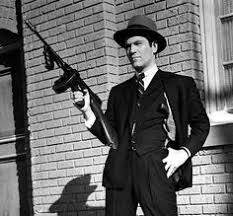On our trip to Tucson earlier this year, we stumbled upon some John Dillinger history. (See Post #845). Hoosier-born Dillinger was classified as a gangster not a mobster, but they all seemed to gravitate to the big city. As I wandered around Chicago on my own, my first stop was at Harry Caray’s Italian Steakhouse at their River North location for a martini. I’ve been there dozens of times but mostly for the sports memorabilia that are part of the decor. I was surprised to find out that the building itself was once owned by the Carravetta family, whose daughter was married to mobster Frank Nitti (really Nitto). Nitti was known as “The Enforcer,” and one of Al Capone’s top lieutenants. The Nitti family lived in an apartment just above the space the current restaurant occupies on the fourth floor. Plus, just below the bar, a secret room was discovered in 1998. It allowed me to step back in time to mobster-life a hundred years ago.
If you go down the stairs from the bar, there’s a goldmine of artifacts including a address book containing contact information for numerous alleged Chicago gangsters, a three-door safe from the early 1900s, escape tunnels, secret rooms, original newspaper articles and photographs depicting the crimes of Chicago gangsters. It was just another bit of gangster history that I’ve happened upon this year as a rambling retiree. Frank Natti eventually took over the Capone empire once Al was convicted of tax evasion in 1931. Both apparently served time for the crime, but Natti got out much sooner.
Upstairs from the bar is Natti’s Speakeasy, where a bookcase button gets you into a secret entertainment area finished in 20’s era decor. To add to the whole Natti mobster legend, his ghost complete with a fedora apparently haunts the building. Frank Natti shot himself in 1943 on the day before he was to appear before a grand jury on extortion charges related to the Hollywood film industry. Al Capone and Frank Natti were childhood acquaintances from a Brooklyn neighborhood that were reunited through mob boss “Papa” Johnny Torrio. Capone, known also as “Scarface,” was released from Alcatraz in 1939 but spent most of his remaining years in hospitals, eventually dying of heart failure early in 1947. Fellow gangster Dillinger died in front of Chicago’s Biograph Theater after watching the Mickey Rooney, Clark Gable movie, “Manhatten Melodrama,” about fictional gangsters.
To add even more to the Frank Natti story, he had a narrow escape from death the year after he took over from Capone when Chicago police detective Harry Lang claimed that he fired on Natti in self-defense. It purportedly took place at Natti’s office at 221 North LaSalle just a block from our Chicago Cut Steakhouse dinner reservation last night. Lang shot himself in the arm to support his claim, but court testimony ruled against him. Apparently, Chicago mayor Anton Cermak ordered the attempted murder of Natti and other gangsters who “did not answer to him.” Natti was shot three times in the back and neck in the scuffle but survived. This incident eventually led to Lang’s firing from the police force. Mayor Cermak, in turn, was shot and killed by a gunman is he was talking to President-elect Franklin D. Roosevelt. Historians believe that the bullet was intended for Roosevelt. It’s all part of Chicago gangland lore.
Dillinger, Capone, and now Natti apparently play a role in this year’s retirement continuing education on mobsters & gangsters. They all saw their lives end in tragedy, proving once again that “crime doesn’t pay (in the long run).” During the Prohibition-era, Chicago never earned the title of “murder capital of the world,” but there were certainly many high-profile crimes, as I’ve uncovered these past few months of retirement. I just hope the Cubs don’t get “murdered” this afternoon by the Angels.

Leave a Reply